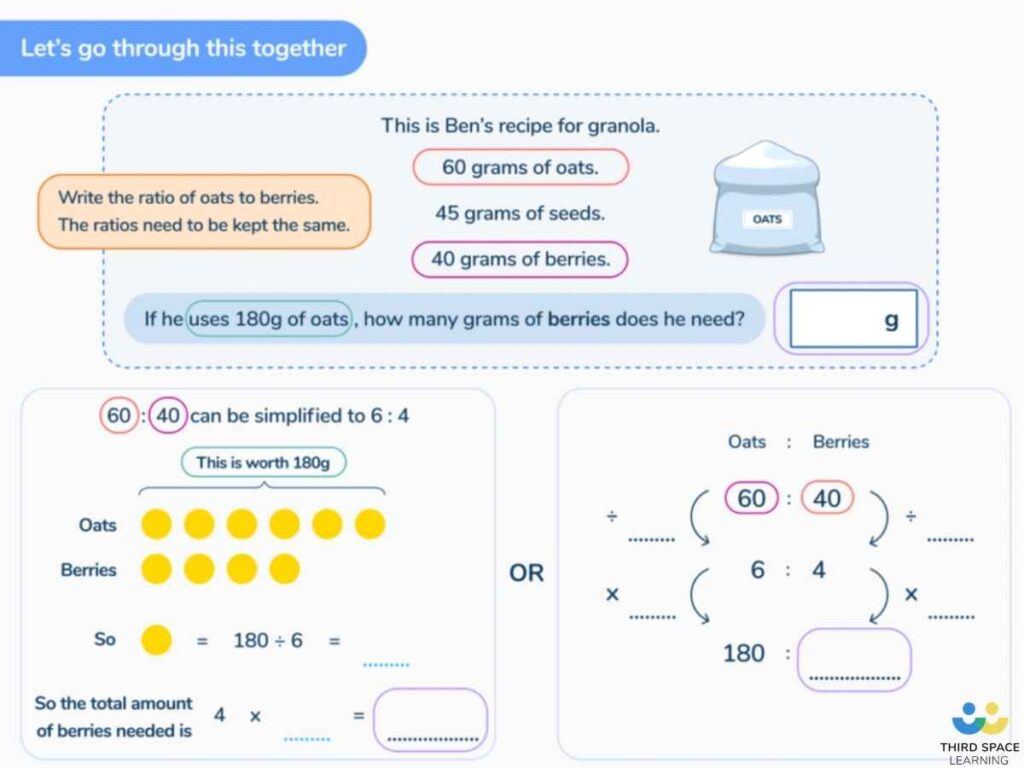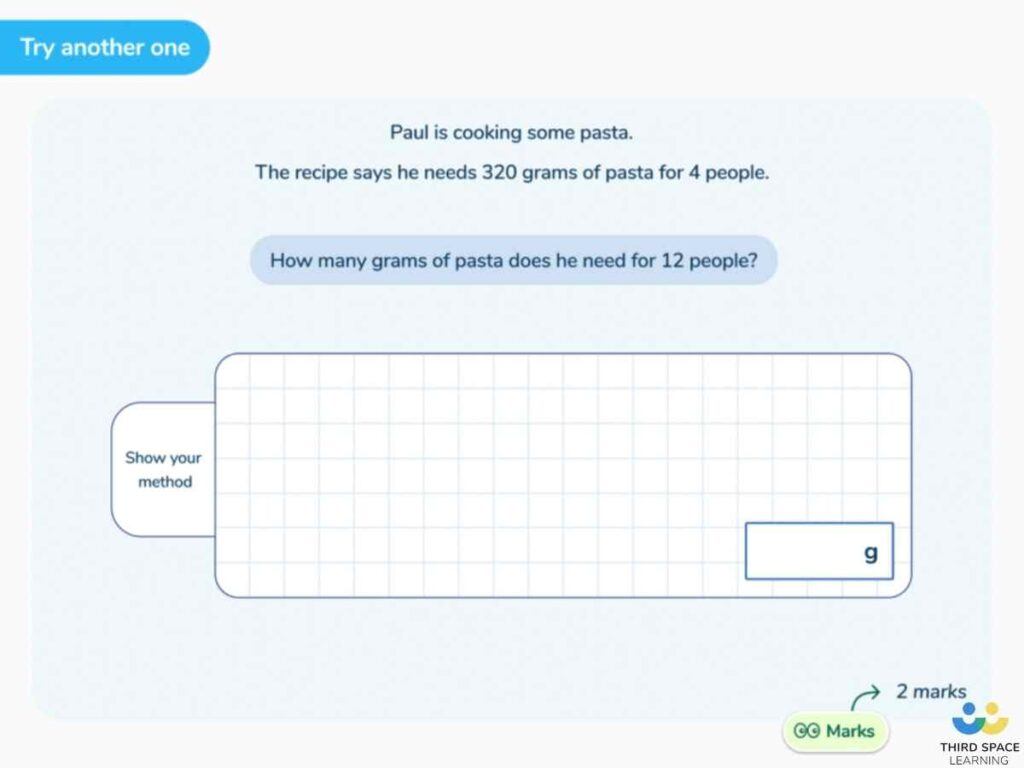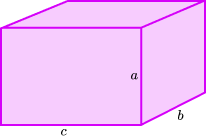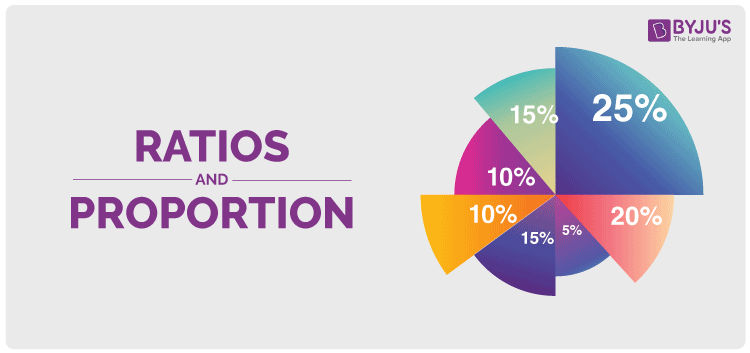A ratio compares values .
A ratio says how much of one thing there is compared to another thing.
Ratios can be shown in different ways:
| Use the ":" to separate the values: | 3 : 1 | |
| Or we can use the word "to": | 3 to 1 | |
| Or write it like a fraction: |
A ratio can be scaled up:

Try it Yourself
Using ratios.
The trick with ratios is to always multiply or divide the numbers by the same value .
| is the same as ×2 ×2 |
Example: A Recipe for pancakes uses 3 cups of flour and 2 cups of milk.
So the ratio of flour to milk is 3 : 2
To make pancakes for a LOT of people we might need 4 times the quantity, so we multiply the numbers by 4:
3 ×4 : 2 ×4 = 12 : 8
In other words, 12 cups of flour and 8 cups of milk .
The ratio is still the same, so the pancakes should be just as yummy.
"Part-to-Part" and "Part-to-Whole" Ratios
The examples so far have been "part-to-part" (comparing one part to another part).
But a ratio can also show a part compared to the whole lot .
Example: There are 5 pups, 2 are boys, and 3 are girls
Part-to-Part:
The ratio of boys to girls is 2:3 or 2 / 3
The ratio of girls to boys is 3:2 or 3 / 2
Part-to-Whole:
The ratio of boys to all pups is 2:5 or 2 / 5
The ratio of girls to all pups is 3:5 or 3 / 5
Try It Yourself
We can use ratios to scale drawings up or down (by multiplying or dividing).
| The height to width ratio of the Indian Flag is So for every (inches, meters, whatever) of height | |
| If we made the flag 20 inches high, it should be 30 inches wide. If we made the flag 40 cm high, it should be 60 cm wide (which is still in the ratio 2:3) | |
Example: To draw a horse at 1/10th normal size, multiply all sizes by 1/10th
This horse in real life is 1500 mm high and 2000 mm long, so the ratio of its height to length is
1500 : 2000
What is that ratio when we draw it at 1/10th normal size?
| 1500 : 2000 | = 1500 : 2000 | |
| = |
We can make any reduction/enlargement we want that way.
| Allie measured her foot and it was 21cm long, and then she measured her Mother's foot, and it was 24cm long. |
"I must have big feet, my foot is nearly as long as my Mom's!"
But then she thought to measure heights, and found she is 133cm tall, and her Mom is 152cm tall.
In a table this is:
| Allie | Mom | |
| Length of Foot: | 21cm | 24cm |
| Height: | 133cm | 152cm |
The "foot-to-height" ratio in fraction style is:
| Allie: | Mom: |
We can simplify those fractions like this:
And we get this (please check that the calcs are correct):
"Oh!" she said, "the Ratios are the same".
"So my foot is only as big as it should be for my height, and is not really too big."
You can practice your ratio skills by Making Some Chocolate Crispies

Maths with Mum
Be your child's best tutor
Solving Ratio Problems

- We add the parts of the ratio to find the total number of parts.
- There are 2 + 3 = 5 parts in the ratio in total.
- To find the value of one part we divide the total amount by the total number of parts.
- 50 ÷ 5 = 10.
- We multiply the ratio by the value of each part.
- 2:3 multiplied by 10 gives us 20:30.
- The 50 counters are shared into 20 counters to 30 counters.

- 2 + 3 = 5 and so there are 5 parts in the ratio in total.
- We divide by this total number of parts to find the value of each part.
- We multiply the original ratio by the value of each part.
- We have 20:30.

- Sharing in a Ratio: Part 1

Ratio Problems: Worksheets and Answers

How to Solve Ratio Problems

Share this:
- Click to share on Twitter (Opens in new window)
- Click to share on Facebook (Opens in new window)
- Click to share on WhatsApp (Opens in new window)
- Click to share on Pinterest (Opens in new window)
- Click to email a link to a friend (Opens in new window)
- Click to print (Opens in new window)
- Click to share on Tumblr (Opens in new window)
- Click to share on Pocket (Opens in new window)
- Click to share on Telegram (Opens in new window)
- Click to share on Skype (Opens in new window)
A free service from Mattecentrum
Ratios and proportions and how to solve them
Let's talk about ratios and proportions. When we talk about the speed of a car or an airplane we measure it in miles per hour. This is called a rate and is a type of ratio. A ratio is a way to compare two quantities by using division as in miles per hour where we compare miles and hours.
A ratio can be written in three different ways and all are read as "the ratio of x to y"
$$x\: to\: y$$
$$\frac{x}{y}$$
A proportion on the other hand is an equation that says that two ratios are equivalent. For instance if one package of cookie mix results in 20 cookies than that would be the same as to say that two packages will result in 40 cookies.
$$\frac{20}{1}=\frac{40}{2}$$
A proportion is read as "x is to y as z is to w"
$$\frac{x}{y}=\frac{z}{w} \: where\: y,w\neq 0$$
If one number in a proportion is unknown you can find that number by solving the proportion.
You know that to make 20 pancakes you have to use 2 eggs. How many eggs are needed to make 100 pancakes?
| 2 | 20 | |
| x | 100 |
$$\frac{eggs}{pancakes}=\frac{eggs}{pancakes}\: \: or\: \: \frac{pancakes}{eggs}=\frac{pancakes}{eggs}$$
If we write the unknown number in the nominator then we can solve this as any other equation
$$\frac{x}{100}=\frac{2}{20}$$
Multiply both sides with 100
$${\color{green} {100\, \cdot }}\, \frac{x}{100}={\color{green} {100\, \cdot }}\, \frac{2}{20}$$
$$x=\frac{200}{20}$$
If the unknown number is in the denominator we can use another method that involves the cross product. The cross product is the product of the numerator of one of the ratios and the denominator of the second ratio. The cross products of a proportion is always equal
If we again use the example with the cookie mix used above
$$\frac{{\color{green} {20}}}{{\color{blue} {1}}}=\frac{{\color{blue} {40}}}{{\color{green} {2}}}$$
$${\color{blue} {1}}\cdot {\color{blue} {40}}={\color{green} {2}}\cdot {\color{green} {20}}=40$$
It is said that in a proportion if
If you look at a map it always tells you in one of the corners that 1 inch of the map correspond to a much bigger distance in reality. This is called a scaling. We often use scaling in order to depict various objects. Scaling involves recreating a model of the object and sharing its proportions, but where the size differs. One may scale up (enlarge) or scale down (reduce). For example, the scale of 1:4 represents a fourth. Thus any measurement we see in the model would be 1/4 of the real measurement. If we wish to calculate the inverse, where we have a 20ft high wall and wish to reproduce it in the scale of 1:4, we simply calculate:
$$20\cdot 1:4=20\cdot \frac{1}{4}=5$$
In a scale model of 1:X where X is a constant, all measurements become 1/X - of the real measurement. The same mathematics applies when we wish to enlarge. Depicting something in the scale of 2:1 all measurements then become twice as large as in reality. We divide by 2 when we wish to find the actual measurement.
Video lesson
$$\frac{x}{x + 20} = \frac{24}{54}$$
- The coordinate plane
- Linear equations in the coordinate plane
- The slope of a linear function
- The slope-intercept form of a linear equation
- Writing linear equations using the slope-intercept form
- Writing linear equations using the point-slope form and the standard form
- Parallel and perpendicular lines
- Scatter plots and linear models
- Solving linear inequalities
- Solving compound inequalities
- Solving absolute value equations and inequalities
- Linear inequalities in two variables
- Graphing linear systems
- The substitution method for solving linear systems
- The elimination method for solving linear systems
- Systems of linear inequalities
- Properties of exponents
- Scientific notation
- Exponential growth functions
- Monomials and polynomials
- Special products of polynomials
- Polynomial equations in factored form
- Use graphing to solve quadratic equations
- Completing the square
- The quadratic formula
- The graph of a radical function
- Simplify radical expressions
- Radical equations
- The Pythagorean Theorem
- The distance and midpoint formulas
- Simplify rational expression
- Multiply rational expressions
- Division of polynomials
- Add and subtract rational expressions
- Solving rational equations
- Algebra 2 Overview
- Geometry Overview
- SAT Overview
- ACT Overview

- HW Guidelines
- Study Skills Quiz
- Find Local Tutors
- Demo MathHelp.com
- Join MathHelp.com
Select a Course Below
- ACCUPLACER Math
- Math Placement Test
- PRAXIS Math
- + more tests
- 5th Grade Math
- 6th Grade Math
- Pre-Algebra
- College Pre-Algebra
- Introductory Algebra
- Intermediate Algebra
- College Algebra
Ratios Proportions Proportionality Solving Word Problems Similar Figures Sun's Rays / Parts
What is a ratio?
A "ratio" is just a comparison between, or a relating of, two different things. Ratios are used to create proportions by setting two ratios equal to each other and solving for some unknown, and ratios can also be used to find per-unit rates such as how many mile a car can drive "per liter" or how many hours the average student at a given university spends studying "per week".
Content Continues Below
MathHelp.com

What is an example of finding a ratio?
As an example of a ratio, someone can look at a group of people, count noses, and refer to the "ratio of men to women" in the group. Suppose there are thirty-five people, fifteen of whom are men. Then the rest are women, so:
35 − 15 = 20
...there are twenty women in the group. The language "the ratio of (this) to (that)" means that (this) comes before (that) in the comparison. So, if one were to express "the ratio of men to women", then the ratio, in English words, would be " 15 men to 20 women" (or just " 15 to 20 ").
Advertisement
The order of the items in a ratio is very important, and must be respected; whichever word came first in the ratio (when expressed in words), its number must come first in the ratio. If the expression had been "the ratio of women to men", then the in-words expression would have been " 20 women to 15 men" (or just " 20 to 15 ").
Expressing the ratio of men to women as " 15 to 20 " is expressing the ratio in words. There are two other notations for this " 15 to 20 " ratio:
odds notation: 15 : 20
You should be able to recognize all three notations; you will probably be expected to know them, and how to convert between them, on the next test. For example:
There are 16 ducks and 9 geese in a certain park. Express the ratio of ducks to geese as a ratio with a colon, as a fraction (do not reduce), and in words.
They want "the ratio of ducks to geese", so the number for the ducks comes first (or, for the fractional form, on top). So my answer is:
Consider the above park, with 16 ducks and 9 geese. Express the ratio of geese to ducks in all three formats.
This time, they want me to give them "the ratio of geese to ducks". I'll be using the exact same numbers but, in this case, the number of geese comes first (or, for the fractional form, on top). So my answer is:
The numbers were the same in each of the two exercises above, but the order in which they were listed differed, varying according to the order in which the elements of the ratio were expressed. In ratios, order is very important.
In a certain class, the ratio of passing grades to failing grades is 7 to 5 . How many of the 36 students failed the course?
So the representative group has 12 students in it, of which 7 passed and 5 failed. In particular, the fraction of the group that failed is given by dividing the number of flunking students by the total number of students in the representative group. That is:
( 5 / 12 )(36) = 15
So, of the class of 36 students, the class was not passed by:
15 students
The ratio from a representative group can also be used to provide percentage information.
In the class above, what percentage of students passed the class? (Round your answer to one decimal place.)
I already know that the representative group contains 12 students, of which 7 passed the class. Converting this to a percentage (by dividing, and then moving the decimal point, as explained here ), I get:
7/12 = 0.583333... = 58.3333...%
They want the answer rounded to one decimal place, so my answer is:
58.3% passed
In the park mentioned previously, the ratio of ducks to geese is 16 to 9 . How many of the 300 birds are geese?
(9/25)(300) = 108
This is the number they're wanting. In the entire park, there are:
Generally, ratio problems will just be a matter of stating ratios or simplifying them. For instance:
Express the following ratio in simplest form: $10 to $45
This exercise wants me to write the ratio as a reduced fraction. So first I'll form the fraction, and then I'll do the cancelling that leads to "simplest form".
$10 / $45 = $2 / $9 = 2 / 9
The dollar signs cancelled off, too, because they were the same, top and bottom, in the ratio's fractional form. So my answer is:
This reduced fraction is the ratio's expression in simplest fractional form. The units (being the "dollar" signs) cancelled on the fraction because the units (namely, the " $ " symbols) were the same on both values.
When both values in a ratio have the same unit or designator, there should be no unit or designator on the reduced form of the ratio. The units aren't factors, exactly, but they'll cancel in the same manner as do factors.
Express the following ratio in simplest form: 240 miles to 8 gallons
The terms in this ratio have different units, so they won't cancel off; there will be units on my simplified ratio. My simplification looks like this:
( 240 miles) / ( 8 gallons)
= ( 30 miles) / ( 1 gallon)
This particular ratio of units, "(miles)/(gallon)", has its own simplified form; namely, "miles per gallon", which is abbreviated as "mpg". So, in standard English, my answer is:
In contrast to the answer to the previous exercise, this exercise's answer did need to have units on it, since the units on the two parts of the ratio (namely, the "miles" and the "gallons") were not the same, and thus did not cancel each other off. When a ratio ends up with units (or dimensions) on it, the ratio may also be referred to as a "rate". In the case of the exercise above, the rate was the distance covered per unit-volume of fuel.
What is the length, in feet, of the playing area of an American football field (that is, the length of the field exclusive of the "end" zones)?
I know that the length of an American football field , exclusive of the "end" zones, is 100 yards. I also know that 3 feet are equal to 1 yard. I can set up this equality as a ratio. Because they've given me a measurement in "yards", I'll want the unit of "yards" to cancel off in my multiplication. Because of this, I'll state my ratio (of yards to feet) with the "feet" on top:
( 3 feet)/( 1 yard)
Now I can multiply the length they've given me by my conversion factor (being the ratio above), and simplify:
[( 3 feet)/( 1 yard)][ 100 yards]
= ( 3 feet)( 100 ) = 300 feet
This value is the number they're wanting, so my answer is:
For more on this topic, look at the " Cancelling / Converting Units " lesson.
Ratios are the comparison of one thing to another (miles to gallons, feet to yards, ducks to geese, et cetera). But their true usefulness comes in the setting up and solving of proportions.
You can use the Mathway widget below to practice converting ratios, expressed in "odds" notation, to fractional form. Try the entered exercise, or type in your own exercise. Then click the button and select "Convert to a Simplified Fraction" to compare your answer to Mathway's. (Or skip the widget, and continue on to the next page .)
Please accept "preferences" cookies in order to enable this widget.
(Click "Tap to view steps" to be taken directly to the Mathway site for a paid upgrade.)
URL: https://www.purplemath.com/modules/ratio.htm
Page 1 Page 2 Page 3 Page 4 Page 5 Page 6 Page 7
Standardized Test Prep
College math, homeschool math, share this page.
- Terms of Use
- About Purplemath
- About the Author
- Tutoring from PM
- Advertising
- Linking to PM
- Site licencing
Visit Our Profiles

Ratio: Problem Solving Textbook Exercise
Click here for questions, gcse revision cards.

5-a-day Workbooks

Primary Study Cards

Privacy Policy
Terms and Conditions
Corbettmaths © 2012 – 2024
Ratio Math Problems - Three Term Ratios
In these lessons, we will learn how to solve ratio word problems that involve three terms.
Related Pages Two-Term Ratio Word Problems More Ratio Word Problems Math Word Problems More Algebra Lessons
Ratio problems are word problems that use ratios to relate the different items in the question.
Ratio problems: Three-term Ratios
Example 1: A special cereal mixture contains rice, wheat and corn in the ratio of 2:3:5. If a bag of the mixture contains 3 pounds of rice, how much corn does it contain?
Step 2: Solve the equation: Cross Multiply
2 × x = 3 × 5 2x = 15
Answer: The mixture contains 7.5 pounds of corn.
Example 2: Clothing store A sells T-shirts in only three colors: red, blue and green. The colors are in the ratio of 3 to 4 to 5. If the store has 20 blue T-shirts, how many T-shirts does it have altogether?
Solution: Step 1: Assign variables: Let x = red shirts y = green shirts
Step 2: Solve the equation: Cross Multiply both equations 3 × 20 = x × 4 60 = 4x x = 15
5 × 20 = y × 4 100 = 4y y = 25
The total number of shirts would be 15 + 25 + 20 = 60
Answer: There are 60 shirts.
How to solve Ratio Word Problems with three terms?
Example: A piece of string that is 63 inches long is cut into 3 parts such that the lengths of the parts of the string are in the ratio of 5 to 6 to 10. Find the lengths of the 3 parts.
How to solve Two Term and Three Term Ratio Problems?
A Ratio compares two things that have the same units A Part to Part Ratio compares one thing to another thing A Part to Total (whole) Ratio compares one thing to the total number
Example: In a class of 30 students, there are 18 girls and 12 boys. What is the ratio of boys to girls? What is the ratio of girls to boys? What is the ratio of girls to total?
We can have a three term ratio of red to blue to green marbles.

We welcome your feedback, comments and questions about this site or page. Please submit your feedback or enquiries via our Feedback page.

Basic Version - No Themes or Artwork

- PRO Courses Guides New Tech Help Pro Expert Videos About wikiHow Pro Upgrade Sign In
- EDIT Edit this Article
- EXPLORE Tech Help Pro About Us Random Article Quizzes Request a New Article Community Dashboard This Or That Game Happiness Hub Popular Categories Arts and Entertainment Artwork Books Movies Computers and Electronics Computers Phone Skills Technology Hacks Health Men's Health Mental Health Women's Health Relationships Dating Love Relationship Issues Hobbies and Crafts Crafts Drawing Games Education & Communication Communication Skills Personal Development Studying Personal Care and Style Fashion Hair Care Personal Hygiene Youth Personal Care School Stuff Dating All Categories Arts and Entertainment Finance and Business Home and Garden Relationship Quizzes Cars & Other Vehicles Food and Entertaining Personal Care and Style Sports and Fitness Computers and Electronics Health Pets and Animals Travel Education & Communication Hobbies and Crafts Philosophy and Religion Work World Family Life Holidays and Traditions Relationships Youth
- Browse Articles
- Learn Something New
- Quizzes Hot
- Happiness Hub
- This Or That Game
- Train Your Brain
- Explore More
- Support wikiHow
- About wikiHow
- Log in / Sign up
- Education and Communications
- Mathematics
How to Calculate Ratios
Last Updated: January 29, 2024 References
This article was co-authored by Grace Imson, MA . Grace Imson is a math teacher with over 40 years of teaching experience. Grace is currently a math instructor at the City College of San Francisco and was previously in the Math Department at Saint Louis University. She has taught math at the elementary, middle, high school, and college levels. She has an MA in Education, specializing in Administration and Supervision from Saint Louis University. This article has been viewed 3,180,918 times.
Ratios are mathematical expressions that compare two or more numbers. They can compare absolute quantities and amounts or can be used to compare portions of a larger whole. Ratios can be calculated and written in several different ways, but the principles guiding the use of ratios are universal to all.
Practice Problems

Understanding Ratios

- Ratios can be used to show the relation between any quantities, even if one is not directly tied to the other (as they would be in a recipe). For example, if there are five girls and ten boys in a class, the ratio of girls to boys is 5 to 10. Neither quantity is dependent on or tied to the other, and would change if anyone left or new students came in. The ratio merely compares the quantities.

- You will commonly see ratios represented using words (as above). Because they are used so commonly and in such a variety of ways, if you find yourself working outside of mathematic or scientific fields, this may the most common form of ratio you will see.
- Ratios are frequently expressed using a colon. When comparing two numbers in a ratio, you'll use one colon (as in 7 : 13). When you're comparing more than two numbers, you'll put a colon between each set of numbers in succession (as in 10 : 2 : 23). In our classroom example, we might compare the number of boys to the number of girls with the ratio 5 girls : 10 boys. We can simply express the ratio as 5 : 10.
- Ratios are also sometimes expressed using fractional notation. In the case of the classroom, the 5 girls and 10 boys would be shown simply as 5/10. That said, it shouldn't be read out loud the same as a fraction, and you need to keep in mind that the numbers do not represent a portion of a whole.
Using Ratios

- In the classroom example above, 5 girls to 10 boys (5 : 10), both sides of the ratio have a factor of 5. Divide both sides by 5 (the greatest common factor) to get 1 girl to 2 boys (or 1 : 2). However, we should keep the original quantities in mind, even when using this reduced ratio. There are not 3 total students in the class, but 15. The reduced ratio just compares the relationship between the number of boys and girls. There are 2 boys for every girl, not exactly 2 boys and 1 girl.
- Some ratios cannot be reduced. For example, 3 : 56 cannot be reduced because the two numbers share no common factors - 3 is a prime number, and 56 is not divisible by 3.

- For example, a baker needs to triple the size of a cake recipe. If the normal ratio of flour to sugar is 2 to 1 (2 : 1), then both numbers must be increased by a factor of three. The appropriate quantities for the recipe are now 6 cups of flour to 3 cups of sugar (6 : 3).
- The same process can be reversed. If the baker needed only one-half of the normal recipe, both quantities could be multiplied by 1/2 (or divided by two). The result would be 1 cup of flour to 1/2 (0.5) cup of sugar.

- For example, let's say we have a small group of students containing 2 boys and 5 girls. If we were to maintain this proportion of boys to girls, how many boys would be in a class that contained 20 girls? To solve, first, let's make two ratios, one with our unknown variables: 2 boys : 5 girls = x boys : 20 girls. If we convert these ratios to their fraction forms, we get 2/5 and x/20. If you cross multiply, you are left with 5x=40, and you can solve by dividing both figures by 5. The final solution is x=8.
Grace Imson, MA
Look at the order of terms to figure out the numerator and denominator in a word problem. The first term is usually the numerator, and the second is usually the denominator. For example, if a problem asks for the ratio of the length of an item to its width, the length will be the numerator, and width will be the denominator.
Catching Mistakes

- Wrong method: "8 - 4 = 4, so I added 4 potatoes to the recipe. That means I should take the 5 carrots and add 4 to that too... wait! That's not how ratios work. I'll try again."
- Right method: "8 ÷ 4 = 2, so I multiplied the number of potatoes by 2. That means I should multiply the 5 carrots by 2 as well. 5 x 2 = 10, so I want 10 carrots total in the new recipe."

- A dragon has 500 grams of gold and 10 kilograms of silver. What is the ratio of gold to silver in the dragon's hoard?

- The dragon has 500 grams of gold and 10,000 grams of silver.

- Example problem: If you have six boxes, and in every three boxes there are nine marbles, how many marbles do you have?

One common problem is knowing which number to use as a numerator. In a word problem, the first term stated is usually the numerator and the second term stated is usually the denominator. If you want the ratio of the length of an item to the width, length becomes your numerator and width becomes your denominator.
Community Q&A
You Might Also Like

- ↑ http://www.virtualnerd.com/common-core/grade-6/6_RP-ratios-proportional-relationships/A
- ↑ http://www.purplemath.com/modules/ratio.htm
- ↑ http://www.helpwithfractions.com/math-homework-helper/least-common-denominator/
- ↑ http://www.mathplanet.com/education/algebra-1/how-to-solve-linear-equations/ratios-and-proportions-and-how-to-solve-them
- ↑ http://www.math.com/school/subject1/lessons/S1U2L2DP.html
About This Article

To calculate a ratio, start by determining which 2 quantities are being compared to each other. For example, if you wanted to know the ratio of girls to boys in a class where there are 5 girls and 10 boys, 5 and 10 would be the quantities you're comparing. Then, put a colon or the word "to" between the numbers to express them as a ratio. In this example, you'd write "5 to 10" or "5:10." Finally, simplify the ratio if possible by dividing both numbers by the greatest common factor. To learn how to solve equations and word problems with ratios, scroll down! Did this summary help you? Yes No
- Send fan mail to authors
Reader Success Stories
Stew Jackson
Feb 9, 2021
Did this article help you?
Maria Bustos
May 3, 2021
Lynn Robinson
Apr 17, 2017
Mar 15, 2019
Dec 11, 2021

Featured Articles

Trending Articles

Watch Articles

- Terms of Use
- Privacy Policy
- Do Not Sell or Share My Info
- Not Selling Info
wikiHow Tech Help Pro:
Level up your tech skills and stay ahead of the curve
High Impact Tutoring Built By Math Experts
Personalized standards-aligned one-on-one math tutoring for schools and districts
Free ready-to-use math resources
Hundreds of free math resources created by experienced math teachers to save time, build engagement and accelerate growth

Ratio Questions And Practice Problems: Differentiated Practice Questions Included
Beki Christian
Ratio questions appear throughout middle and high school, building on students’ knowledge year on year. Here we provide a range of ratio questions and practice problems of varying complexity to use with your own students in class or as inspiration for creating your own.

What is ratio?
Ratio is used to compare the size of different parts of a whole. For example, the total number of students in a class is 30. There are 10 girls and 20 boys. The ratio of girls:boys is 10:20 or 1:2. For every one girl there are two boys.

Ratio Worksheet
Download this quiz to check your students’ understanding of ratios. Features 10 questions with answers to identify areas of strength and support!
Uses of ratio
You might see ratios written on maps to show the scale of the map or use ratios to determine the currency exchange rate if you are going on vacation to another country.
Ratio will be seen as a topic in its own right as well as appearing within other topics. An example of this might be the area of two shapes being in a given ratio or the angles of a shape being in a given ratio.

Ratio in Middle School and High School
In middle school, ratio questions will involve writing and simplifying ratios, using equivalent ratios, dividing quantities into a given ratio and will begin to look at solving problems involving ratio. At high school, these skills are recapped and the focus will be more on ratio word problems which will require you to conduct problem solving using your knowledge of ratio.
Proportion and ratio
Ratio often appears alongside proportion and the two topics are related. Whereas ratio compares the size of different parts of a whole, proportion compares the size of one part with the whole. Given a ratio, we can find a proportion and vice versa.
Take the example of a box containing 7 counters; 3 red counters and 4 blue counters:
The ratio of red counters:blue counters is 3:4.
For every 3 red counters there are four blue counters.
The proportion of red counters is \frac{3}{7} and the proportion of blue counters is \frac{4}{7}.
3 out of every 7 counters are red and 4 out of every 7 counters are blue.
Direct proportion and inverse proportion
From 7th grade onwards, students learn about direct proportion and inverse proportion. When two things are directly proportional to each other, one can be written as a multiple of the other and therefore they increase at a fixed ratio.
How to solve a ratio problem
When looking at a ratio problem, the key pieces of information that you need are what the ratio is, whether you have been given the whole amount or a part of the whole and what you are trying to work out.
If you have been given the whole amount you can follow these steps to answer the question:
- Add together the parts of the ratio to find the total number of shares.
- Divide the total amount by the total number of shares.
- Multiply by the number of shares required.
If you have been been given a part of the whole you can follow these steps:
- Identify which part you have been given and how many shares it is worth.
- Use equivalent ratios to find the other parts.
- Use the values you have to answer your problem.
How to solve a proportion problem
As we have seen, ratio and proportion are strongly linked. If we are asked to find what proportion something is of a total, we need to identify the amount in question and the total amount. We can then write this as a fraction:
Proportion problems can often be solved using scaling. To do this you can follow these steps:
- Identify the values that you have been given which are proportional to each other.
- Use division to find an equivalent relationship.
- Use multiplication to find the required relationship.
Real life ratio problems and proportion problems
Ratio is all around us. Let’s look at some examples of where we may see ratio and proportion:
Cooking ratio question
When making yogurt, the ratio of starter yogurt to milk should be 1:9. I want to make 1,000 ml of yogurt. How much milk should I use?
Here we know the full amount – 1,000 ml.
The ratio is 1:9 and we want to find the amount of milk.
- Total number of shares = 1 + 9 = 10
- Value of each share: 1,000 ÷ 10 = 100
- The milk is 9 shares so 9 × 100 = 900
I need to use 900ml of milk.
Maps ratio question
The scale on a map is 1:10,000. What distance would 3.5cm on the map represent in real life?
Here we know one part is 3.5. We can use equivalent ratios to find the other part.
The distance in real life would be 35,000cm or 350m.
Speed proportion question
I traveled 60 miles in 2 hours. Assuming my speed doesn’t change, how far will I travel in 3 hours?
This is a proportion question.
- I traveled 60 miles in 2 hours.
- Dividing by 2, I traveled 30 miles in one hour.
- Multiplying by 3, I would travel 90 miles in 3 hours.

Middle School ratio questions
Ratio is introduced in middle school. Writing and simplifying ratios is explored and the idea of dividing quantities in a given ratio is introduced using proportion word problems such as the question below, before being linked with the mathematical notation of ratio.
Example Middle School worded question
Richard has a bag of 30 sweets. Richard shares the sweets with a friend. For every 3 sweets Richard eats, he gives his friend 2 sweets. How many sweets do they each eat?
Practice ratio questions for middle school
At this level, ratio questions ask you to write and simplify a ratio, to divide quantities into a given ratio and to solve problems using equivalent ratios. See below the example questions to support test prep.
Ratio questions for 6th grade
1. In Lucy’s class there are 12 boys and 18 girls. Write the ratio of girls to boys in its simplest form.

The question asks for the ratio of girls to boys, so girls must be first and boys second. It also asks for the answer in its simplest form.
2. The ratio of cups of flour to cups of water in a pizza dough recipe is 9:4. A pizza restaurant makes a large quantity of dough, using 36 cups of flour. How much water should they use?
The ratio of cups of flour to cups of water is 9:4. We have been given one part so we can work this out using equivalent ratios.
Ratio questions 7th grade
3. The ratio of men to women working in a company is 3:5. What proportion of the employees are women?
In this company, the ratio of men to women is 3:5 so for every 3 men there are 5 women.
This means that for every 8 employees, 5 of them are women.
Therefore \frac{5}{8} of the employees are women.
4. Mac traveled 30 miles in \frac{3}{4} of an hour. Assuming his speed doesn’t change, how far will Mac travel in 1 hour?
We have been given a part so we can work this out using equivalent ratios.
The ratio of miles to hours is 30: \frac{3}{4} .
To create an equivalent ratio, divide each side by the same number. Since we are solving to find how far Mac will travel in 1 hour, divide both sides by \frac{3}{4} .
30: \frac{3}{4}
30 \div \frac{3}{4}: \frac{3}{4} \div \frac{3}{4}
Mac will travel 40 miles in 1 hour.
Ratio questions 8th grade
While the Common Core State Standards does not explicitly include ratio and proportional relationships in the 8th grade, it may pop up on your own curriculums and offers a good opportunity to revisit and extend their knowledge of ratio and proportion before they enter high school.
5. The angles in a triangle are in the ratio 3:4:5. Work out the size of each angle.
30^{\circ} , 40^{\circ} and 50^{\circ}
22.5^{\circ}, 30^{\circ} and 37.5^{\circ}
60^{\circ} , 60^{\circ} and 60^{\circ}
45^{\circ} , 60^{\circ} and 75^{\circ}
The angles in a triangle add up to 180 ^{\circ} . Therefore 180 ^{\circ} is the whole and we need to divide 180 ^{\circ} in the ratio 3:4:5.
The total number of shares is 3 + 4 + 5 = 12.
Each share is worth 180 ÷ 12 = 15 ^{\circ} .
3 shares is 3 x 15 = 45 ^{\circ} .
4 shares is 4 x 15 = 60 ^{\circ} .
5 shares is 5 x 15 = 75 ^{\circ} .
6. Paint Pro makes pink paint by mixing red paint and white paint in the ratio 3:4.
Colour Co makes pink paint by mixing red paint and white paint in the ratio 5:7.
Which company uses a higher proportion of red paint in their mixture?
They are the same
It is impossible to tell
The proportion of red paint for Paint Pro is \frac{3}{7}
The proportion of red paint for Colour Co is \frac{5}{12}
We can compare fractions by putting them over a common denominator using equivalent fractions
\frac{3}{7} = \frac{36}{84} \hspace{3cm} \frac{5}{12}=\frac{35}{84}
\frac{3}{7} is a bigger fraction so Paint Pro uses a higher proportion of red paint.
High school ratio questions
At high school, we apply the knowledge that we have of ratios to solve different problems. Ratio can be linked with many different topics, for example similar shapes and probability, as well as appearing as problems in their own right.
Ratio high school questions (low difficulty)
7. The students in Ellie’s class walk, cycle or drive to school in the ratio 2:1:4. If 8 students walk, how many students are there in Ellie’s class altogether?
We have been given one part so we can work this out using equivalent ratios.
The total number of students is 8 + 4 + 16 = 28
8. A bag contains counters. 40% of the counters are red and the rest are yellow.
Write down the ratio of red counters to yellow counters. Give your answer in the form 1:n.
If 40% of the counters are red, 60% must be yellow and therefore the ratio of red counters to yellow counters is 40:60. Dividing both sides by 40 to get one on the left gives us
Since the question has asked for the ratio in the form 1:n, it is fine to have decimals in the ratio.
9. Rosie and Jim share some sweets in the ratio 5:7. If Jim gets 12 sweets more than Rosie, work out the number of sweets that Rosie gets.
Jim receives 2 shares more than Rosie, so 2 shares is equal to 12.
Therefore 1 share is equal to 6. Rosie receives 5 shares: 5 × 6 = 30.
10. Rahim is saving for a new bike which will cost $480. Rahim earns $1,500 per month. Rahim spends his money on bills, food and extras in the ratio 8:3:4. Of the money he spends on extras, he spends 80% and puts 20% into his savings account.
How long will it take Rahim to save for his new bike?
Rahim’s earnings of $1,500 are divided in the ratio of 8:3:4.
The total number of shares is 8 + 3 + 4 = 15.
Each share is worth $ 1,500 ÷ 15 = £100 .
Rahim spends 4 shares on extras so 4 × $ 100 = $400 .
20% of $400 is $80.
The number of months it will take Rahim is $ 480 ÷ $ 80 = 6
Ratio GCSE exam questions higher
11. The ratio of milk chocolates to white chocolates in a box is 5:2. The ratio of milk chocolates to dark chocolates in the same box is 4:1.
If I choose one chocolate at random, what is the probability that that chocolate will be a milk chocolate?
To find the probability, we need to find the fraction of chocolates that are milk chocolates. We can look at this using equivalent ratios.
To make the ratios comparable, we need to make the number of shares of milk chocolate the same in both ratios. Since 20 is the LCM of 4 and 5 we will make them both into 20 parts.
We can now say that milk to white to dark is 20:8:5. The proportion of milk chocolates is \frac{20}{33} so the probability of choosing a milk chocolate is \frac{20}{33} .
12. In a school the ratio of girls to boys is 2:3.
25% of the girls have school dinners.
30% of the boys have school dinners.
What is the total percentage of students at the school who have school dinners?
In this question you are not given the number of students so it is best to think about it using percentages, starting with 100%.
100% in the ratio 2:3 is 40%:60% so 40% of the students are girls and 60% are boys.
25% of 40% is 10%.
30% of 60% is 18%.
The total percentage of students who have school dinners is 10 + 18 = 28%.
13. For the cuboid below, a:b = 3:1 and a:c = 1:2.

Find an expression for the volume of the cuboid in terms of a.
If a:b = 3:1 then b=\frac{1}{3}a
If a:c = 1:2 then c=2a.

Ratio high school questions (average difficulty)
14. Bill and Ben win some money in their local lottery. They share the money in the ratio 3:4. Ben decides to give $40 to his sister. The amount that Bill and Ben have is now in the ratio 6:7.
Calculate the total amount of money won by Bill and Ben.
Initially the ratio was 3:4 so Bill got $3a and Ben got $4a. Ben then gave away $40 so he had $(4a-40).
The new ratio is 3a:4a-40 and this is equal to the ratio 6:7.
Since 3a:4a-40 is equivalent to 6:7, 7 lots of 3a must be equal to 6 lots of 4a-40.
The initial amounts were 3a:4a. a is 80 so Bill received $240 and Ben received $320.
The total amount won was $560.
15. On a farm the ratio of pigs to goats is 4:1. The ratio of pigs to piglets is 1:6 and the ratio of goats to kids is 1:2.
What fraction of the animals on the farm are babies?
The easiest way to solve this is to think about fractions.
\\ \frac{4}{5} of the animals are pigs, \frac{1}{5} of the animals are goats.
\frac{1}{7} of the pigs are adult pigs, so \frac{1}{7} of \frac{4}{5} is \frac{1}{7} \times \frac{4}{5} = \frac{4}{35}
\frac{6}{7} of the pigs are piglets, so \frac{6}{7} of \frac{4}{5} is \frac{6}{7} \times \frac{4}{5} = \frac{24}{35}
\frac{1}{3} of the goats are adult goats, so \frac{1}{3} of \frac{1}{5} is \frac{1}{3} \times \frac{1}{5} = \frac{1}{15}
\frac{2}{3} of the goats are kids, so \frac{2}{3} of \frac{1}{5} is \frac{2}{3} \times \frac{1}{5} = \frac{2}{15}
The total fraction of baby animals is \frac{24}{35} + \frac{2}{15} = \frac{72}{105} +\frac{14}{105} = \frac{86}{105}
Looking for more middle school and high school ratio math questions?
- Algebra questions
- Probability questions
- Trigonometry questions
- Venn diagram questions
- Long division questions
- Pythagorean theorem questions
Do you have students who need extra support in math? Give your students more opportunities to consolidate learning and practice skills through personalized math tutoring with their own dedicated online math tutor. Each student receives differentiated instruction designed to close their individual learning gaps, and scaffolded learning ensures every student learns at the right pace. Lessons are aligned with your state’s standards and assessments, plus you’ll receive regular reports every step of the way. Personalized one-on-one math tutoring programs are available for: – 2nd grade tutoring – 3rd grade tutoring – 4th grade tutoring – 5th grade tutoring – 6th grade tutoring – 7th grade tutoring – 8th grade tutoring Why not learn more about how it works ?
Related articles

28 7th Grade Math Problems With Answers And Worked Examples

15 Venn Diagram Questions And Practice Problems (Middle & High School): Exam Style Questions Included

15 Probability Questions And Practice Problems for Middle and High School: Harder Exam Style Questions Included

9 Algebra Questions And Practice Problems To Do With Your Middle Schoolers
Solving Inequalities Questions [FREE]
Downloadable skills and applied questions about solving inequalities.
Includes 10 skills questions, 5 applied questions and an answer key. Print and share with your classes to support their learning.
Privacy Overview
- Math Article
- Ratios And Proportion
Ratios and Proportion

Ratio and Proportion are explained majorly based on fractions. When a fraction is represented in the form of a:b, then it is a ratio whereas a proportion states that two ratios are equal. Here, a and b are any two integers. The ratio and proportion are the two important concepts, and it is the foundation to understand the various concepts in mathematics as well as in science.

In our daily life, we use the concept of ratio and proportion such as in business while dealing with money or while cooking any dish, etc. Sometimes, students get confused with the concept of ratio and proportion. In this article, the students get a clear vision of these two concepts with more solved examples and problems.
For example, ⅘ is a ratio and the proportion statement is 20/25 = ⅘. If we solve this proportional statement, we get:
20 x 5 = 25 x 4
Check: Ratio and Proportion PDF
Therefore, the ratio defines the relationship between two quantities such as a:b, where b is not equal to 0. Example: The ratio of 2 to 4 is represented as 2:4 = 1:2. And the statement is said to be in proportion here. The application of proportion can be seen in direct proportion .
What is Ratio and Proportion in Maths?
The definition of ratio and proportion is described here in this section. Both concepts are an important part of Mathematics. In real life also, you may find a lot of examples such as the rate of speed (distance/time) or price (rupees/meter) of a material, etc, where the concept of the ratio is highlighted.
Proportion is an equation that defines that the two given ratios are equivalent to each other. For example, the time taken by train to cover 100km per hour is equal to the time taken by it to cover the distance of 500km for 5 hours. Such as 100km/hr = 500km/5hrs.

Let us now learn Maths ratio and proportion concept one by one.
Ratio Meaning
In certain situations, the comparison of two quantities by the method of division is very efficient. We can say that the comparison or simplified form of two quantities of the same kind is referred to as a ratio. This relation gives us how many times one quantity is equal to the other quantity. In simple words, the ratio is the number that can be used to express one quantity as a fraction of the other ones.
The two numbers in a ratio can only be compared when they have the same unit. We make use of ratios to compare two things. The sign used to denote a ratio is ‘:’.
A ratio can be written as a fraction, say 2/5. We happen to see various comparisons or say ratios in our daily life.
Hence, the ratio can be represented in three different forms, such as:
Key Points to Remember:
- The ratio should exist between the quantities of the same kind
- While comparing two things, the units should be similar
- There should be significant order of terms
- The comparison of two ratios can be performed, if the ratios are equivalent like the fractions
Definition of Proportion
Proportion is an equation that defines that the two given ratios are equivalent to each other. In other words, the proportion states the equality of the two fractions or the ratios. In proportion, if two sets of given numbers are increasing or decreasing in the same ratio, then the ratios are said to be directly proportional to each other.
For example, the time taken by train to cover 100km per hour is equal to the time taken by it to cover the distance of 500km for 5 hours. Such as 100km/hr = 500km/5hrs.
Ratio and proportions are said to be faces of the same coin. When two ratios are equal in value, then they are said to be in proportion . In simple words, it compares two ratios. Proportions are denoted by the symbol ‘::’ or ‘=’.
The proportion can be classified into the following categories, such as:
Direct Proportion
Inverse proportion, continued proportion.
Now, let us discuss all these methods in brief:
The direct proportion describes the relationship between two quantities, in which the increases in one quantity, there is an increase in the other quantity also. Similarly, if one quantity decreases, the other quantity also decreases. Hence, if “a” and “b” are two quantities, then the direction proportion is written as a∝b.
The inverse proportion describes the relationship between two quantities in which an increase in one quantity leads to a decrease in the other quantity. Similarly, if there is a decrease in one quantity, there is an increase in the other quantity. Therefore, the inverse proportion of two quantities, say “a” and “b” is represented by a∝(1/b).
Consider two ratios to be a: b and c: d .
Then in order to find the continued proportion for the two given ratio terms, we convert the means to a single term/number. This would, in general, be the LCM of means.
For the given ratio, the LCM of b & c will be bc.
Thus, multiplying the first ratio by c and the second ratio by b, we have
First ratio- ca:bc
Second ratio- bc: bd
Thus, the continued proportion can be written in the form of ca: bc: bd
Ratio and Proportion Formula
Now, let us learn the Maths ratio and proportion formulas here.
Ratio Formula
Assume that, we have two quantities (or two numbers or two entities) and we have to find the ratio of these two, then the formula for ratio is defined as;
where a and b could be any two quantities .
Here, “a” is called the first term or antecedent , and “b” is called the second term or consequent .
Example: In ratio 4:9, is represented by 4/9, where 4 is antecedent and 9 is consequent.
If we multiply and divide each term of ratio by the same number (non-zero), it doesn’t affect the ratio.
Example: 4:9 = 8:18 = 12:27
Also, read: Ratio Formula
Proportion Formula
Now, let us assume that, in proportion, the two ratios are a:b & c:d. The two terms ‘b’ and ‘c’ are called ‘means or mean term,’ whereas the terms ‘a’ and ‘d’ are known as ‘ extremes or extreme terms.’
Example: Let us consider one more example of a number of students in a classroom. Our first ratio of the number of girls to boys is 3:5 and that of the other is 4:8, then the proportion can be written as:
3 : 5 :: 4 : 8 or 3/5 = 4/8
Here, 3 & 8 are the extremes, while 5 & 4 are the means.
Note: The ratio value does not affect when the same non-zero number is multiplied or divided on each term.
Important Properties of Proportion
The following are the important properties of proportion:
- Addendo – If a : b = c : d, then a + c : b + d
- Subtrahendo – If a : b = c : d, then a – c : b – d
- Dividendo – If a : b = c : d, then a – b : b = c – d : d
- Componendo – If a : b = c : d, then a + b : b = c+d : d
- Alternendo – If a : b = c : d, then a : c = b: d
- Invertendo – If a : b = c : d, then b : a = d : c
- Componendo and dividendo – If a : b = c : d, then a + b : a – b = c + d : c – d
Difference Between Ratio and Proportion
To understand the concept of ratio and proportion, go through the difference between ratio and proportion given here.
| S.No | Ratio | Proportion |
| 1 | The ratio is used to compare the size of two things with the same unit | The proportion is used to express the relation of two ratios |
| 2 | It is expressed using a colon (:), slash (/) | It is expressed using the double colon (::) or equal to the symbol (=) |
| 3 | It is an expression | It is an equation |
| 4 | Keyword to identify ratio in a problem is “to every” | Keyword to identify proportion in a problem is “out of” |
Fourth, Third and Mean Proportional
If a : b = c : d, then:
- d is called the fourth proportional to a, b, c.
- c is called the third proportion to a and b.
- Mean proportional between a and b is √(ab).
Comparison of Ratios
If (a:b)>(c:d) = (a/b>c/d)
The compounded ratio of the ratios: (a : b), (c : d), (e : f) is (ace : bdf).
Duplicate Ratios
If a:b is a ratio, then:
- a 2 :b 2 is a duplicate ratio
- √a:√b is the sub-duplicate ratio
- a 3 :b 3 is a triplicate ratio
Ratio and Proportion Tricks
Let us learn here some rules and tricks to solve problems based on ratio and proportion topics.
- If u/v = x/y, then uy = vx
- If u/v = x/y, then u/x = v/y
- If u/v = x/y, then v/u = y/x
- If u/v = x/y, then (u+v)/v = (x+y)/y
- If u/v = x/y, then (u-v)/v = (x-y)/y
- If u/v = x/y, then (u+v)/ (u-v) = (x+y)/(x-y), which is known as componendo -Dividendo Rule
- If a/(b+c) = b/(c+a) = c/(a+b) and a+b+ c ≠0, then a =b = c
Ratio and Proportion Summary
- Ratio defines the relationship between the quantities of two or more objects. It is used to compare the quantities of the same kind.
- If two or more ratios are equal, then it is said to be in proportion.
- The proportion can be represented in two different ways. Either it can be represented using an equal sign or by using a colon symbol. (i.e) a:b = c:d or a:b :: c:d
- If we multiply or divide each term of the ratio by the same number, it does not affect the ratio.
- For any three quantities, the quantities are said to be in continued proportion, if the ratio between the first and second quantity is equal to the ratio between the second and third quantity.
- For any four quantities, they are said to be in continued proportion, if the ratio between the first and second quantities is equal to the ratio between the third and fourth quantities
Ratio And Proportion Examples
Example 1:
Are the ratios 4:5 and 8:10 said to be in Proportion?
4:5= 4/5 = 0.8 and 8: 10= 8/10= 0.8
Since both the ratios are equal, they are said to be in proportion.
Are the two ratios 8:10 and 7:10 in proportion?
8:10= 8/10= 0.8 and 7:10= 7/10= 0.7
Since both the ratios are not equal, they are not in proportion.
Example 3:
Given ratio are-
Find a: b: c.
Multiplying the first ratio by 5, second by 3 and third by 6, we have
a:b = 10: 15
b:c = 15 : 6
c:d = 6 : 24
In the ratio’s above, all the mean terms are equal, thus
a:b:c:d = 10:15:6:24
Check whether the following statements are true or false.
a] 12 : 18 = 28 : 56
b] 25 people : 130 people = 15kg : 78kg
The given statement is false.
12 : 18 = 12 / 18 = 2 / 3 = 2 : 3
28 : 56 = 28 / 56 = 1 / 2 = 1 : 2
They are unequal.
b] 25 persons : 130 persons = 15kg : 78kg
The given statement is true.
25 people : 130 people = 5: 26
15kg : 78kg = 5: 26
They are equal.
The earnings of Rohan is 12000 rupees every month and Anish is 191520 per year. If the monthly expenses of every person are around 9960 rupees. Find the ratio of the savings.
Savings of Rohan per month = Rs (12000-9960) = Rs. 2040
Yearly income of Anish = Rs. 191520
Hence, the monthly income of Anish = Rs. 191520/12 = Rs. 15960.
So, the savings of Anish per month = Rs (15960 – 9960) = Rs. 6000
Thus, the ratio of savings of Rohan and Anish is Rs. 2040: Rs.6000 = 17: 50.
Twenty tons of iron is Rs. 600000 (six lakhs). What is the cost of 560 kilograms of iron?
1 ton = 1000 kg 20 tons = 20000 kg The cost of 20000 kg iron = Rs. 600000 The cost of 1 kg iron = Rs{600000}/ {20000} = Rs. 30 The cost of 560 kg iron = Rs 30 × 560 = Rs 16800
The dimensions of the rectangular field are given. The length and breadth of the rectangular field are 50 meters and 15 meters. What is the ratio of the length and breadth of the field?
Length of the rectangular field = 50 m
Breadth of the rectangular field = 15 m
Hence, the ratio of length to breadth = 50: 15
⇒ 50: 15 = 10: 3.
Thus, the ratio of length and breadth of the rectangular field is 10:3.
Obtain a ratio of 90 centimetres to 1.5 meters.
The given two quantities are not in the same units.
Convert them into the same units.
1.5 m = 1.5 × 100 = 150 cm
Hence, the required ratio is 90 cm: 150 cm
⇒ 90: 150 = 3: 5
Therefore, the ratio of 90 centimetres to 1.5 meters is 3: 5.
There exists 45 people in an office. Out of which female employees are 25 and the remaining are male employees. Find the ratio of
a] The count of females to males.
b] The count of males to females.
Count of females = 25
Total count of employees = 45
Count of males = 45 – 25 = 20
The ratio of the count of females to the count of males
The count of males to the count of females
Example 10:
Write two equivalent ratios of 6: 4.
Given Ratio : 6: 4, which is equal to 6/4.
Multiplying or dividing the same numbers on both numerator and denominator, we will get the equivalent ratio.
⇒(6×2)/(4×2) = 12/8 = 12: 8
⇒(6÷2)/(4÷2) = 3/2 = 3: 2
Therefore, the two equivalent ratios of 6: 4 are 3: 2 and 12: 8
Example 11 :
Out of the total students in a class, if the number of boys is 5 and the number of girls is 3, then find the ratio between girls and boys.
The ratio between girls and boys can be written as 3:5 (Girls: Boys). The ratio can also be written in the form of factor like 3/5.
Example 12:
Two numbers are in the ratio 2 : 3. If the sum of numbers is 60, find the numbers.
Given, 2/3 is the ratio of any two numbers.
Let the two numbers be 2x and 3x.
As per the given question, the sum of these two numbers = 60
So, 2x + 3x = 60
Hence, the two numbers are;
2x = 2 x 12 = 24
3x = 3 x 12 = 36
24 and 36 are the required numbers.
Maths ratio and proportion are used to solve many real-world problems. Register with BYJU’S – The Learning App and get solutions for many difficult questions in easy methodology and followed by the step-by-step procedure.
Frequently Asked Questions on Ratios and Proportion
What is the ratio give an example., what is a proportion give example, how to solve proportions with examples, what is the concept of ratios, what are the two different types of proportions.
The two different types of proportions are: Direct Proportion Inverse Proportion
Can we express ratio in terms of fractions?
Yes, we can express ratio in terms of fractions. For example, 3: 4 can be expressed as 3/4.
What is the formula for ratio and proportion?
The formula for ratio is: x:y ⇒ x/y, where x is the first term and y is the second term. The formula for proportion is: p: q :: r : s ⇒ p/q = r/s, Where p and r are the first term in the first and second ratio q and s are the second term and in the first and second ratio.
Find the means and extremes of the proportion 1: 2 :: 3: 4.
In the given proportion 1: 2 :: 3: 4, Means are 2 and 3 Extremes are 1 and 4.

Put your understanding of this concept to test by answering a few MCQs. Click ‘Start Quiz’ to begin!
Select the correct answer and click on the “Finish” button Check your score and answers at the end of the quiz
Visit BYJU’S for all Maths related queries and study materials
Your result is as below
Request OTP on Voice Call
| MATHS Related Links | |
Leave a Comment Cancel reply
Your Mobile number and Email id will not be published. Required fields are marked *
Post My Comment
Very helpful
Register with BYJU'S & Download Free PDFs
Register with byju's & watch live videos.

IMAGES
VIDEO
COMMENTS
Ratio problem solving is a collection of ratio and proportion word problems that link together aspects of ratio and proportion into more real life questions. This requires you to be able to take key information from a question and use your knowledge of ratios (and other areas of the curriculum) to solve the problem. ...
Ratio Problem Solving - GCSE Maths
In the classroom, ratio problem solving often comes in the form of real world scenarios or word problems. For example, \cfrac{8}{10} students are right handed. What is the ratio of left handed students to right handed students? (2 : 8) Step-by-step guide: Ratio problem solving.
Algebra: Ratio Word Problems
5.5: Ratios and Proportions
Ratios - Math is Fun ... Ratios
Watch this video to learn how to solve ratio problems with tables and practice your skills on Khan Academy, a free online learning platform.
Ratio Practice Questions
Solving Ratio Problems. We add the parts of the ratio to find the total number of parts. There are 2 + 3 = 5 parts in the ratio in total. To find the value of one part we divide the total amount by the total number of parts. 50 ÷ 5 = 10. We multiply the ratio by the value of each part. 2:3 multiplied by 10 gives us 20:30.
Ratios | All About Ratios
20 1 = 40 2 20 1 = 40 2. 1 ⋅40 = 2 ⋅20 = 40 1 ⋅ 40 = 2 ⋅ 20 = 40. It is said that in a proportion if. x y = z w wherey, w ≠ 0 x y = z w w h e r e y, w ≠ 0. xw = yz x w = y z. If you look at a map it always tells you in one of the corners that 1 inch of the map correspond to a much bigger distance in reality.
Ratios: What are They? How do They Work?
The Corbettmaths Textbook Exercise on Ratio: Problem Solving
Art of Problem Solving's Richard Rusczyk introduces ratios.Learn more about problem solving at our website: http://bit.ly/ArtofProblemSolving
Learn all about ratios and solving ratio word problems. Check out all my videos at http://YouTube.com/MathMeeting
Two-Term Ratio Word Problems More Ratio Word Problems Math Word Problems More Algebra Lessons. Ratio problems are word problems that use ratios to relate the different items in the question. Ratio problems: Three-term Ratios. Example 1: A special cereal mixture contains rice, wheat and corn in the ratio of 2:3:5.
Ratios and rates | Pre-algebra | Math
The ratio was 3 : 2. Find the volume of white paint, 2 parts. 2 × 12 = 24. 24 litres of white paint. In total there are 5 parts, so the total volume of paint will be. 5 × 12 = 60. 60 litres in total. (c) In Jamie's sock drawer the ratio of black socks to striped socks is 5 : 2 respectively.
Thinking Blocks Ratios
How to Calculate Ratios: 9 Steps (with Pictures)
At this level, ratio questions ask you to write and simplify a ratio, to divide quantities into a given ratio and to solve problems using equivalent ratios. See below the example questions to support test prep. Ratio questions for 6th grade. 1. In Lucy's class there are 12 boys and 18 girls. Write the ratio of girls to boys in its simplest form.
Ratio and Proportion - Definition, Formulas and Examples